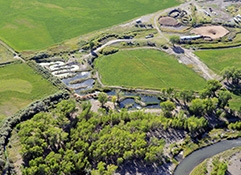2015 EPA Pacific Southwest Progress Report

Clean Air


A Clearer Future for San Joaquin
California's San Joaquin Valley is taking steps to create a healthier environment while modernizing its infrastructure. High-speed rail promises to benefit both public health and the valley's economy.
- Fighting Air Pollution in the Valley »
 EPA Administrator Gina McCarthy, California Governor Jerry Brown and other officials celebrate the start of construction on the high-speed rail project.On January 6, 2015, EPA Administrator Gina McCarthy met with Governor Jerry Brown, Mayor Ashley Swearengin, and other government and transportation leaders in Fresno, Calif., to mark the start of sustained construction on what is anticipated to be the nation's first truly high-speed rail system.
EPA Administrator Gina McCarthy, California Governor Jerry Brown and other officials celebrate the start of construction on the high-speed rail project.On January 6, 2015, EPA Administrator Gina McCarthy met with Governor Jerry Brown, Mayor Ashley Swearengin, and other government and transportation leaders in Fresno, Calif., to mark the start of sustained construction on what is anticipated to be the nation's first truly high-speed rail system.In 2029, the zero-emission electric train is expected to run from San Francisco to Los Angeles in under three hours – the fastest, most environmentally-friendly way to travel between the state's biggest urban areas and within the San Joaquin Valley.
Construction on the rail line will use the cleanest EPA-certified equipment, create jobs and stimulate the valley's economy.
The San Joaquin Valley has some of the nation's toughest air quality challenges. It's a major transportation corridor for heavy-duty trucks, which emit diesel particulate and black carbon pollution.
EPA continues to work with the California Air Resources Board and San Joaquin Valley Unified Air Pollution Control District to help reduce pollution from a full range of pollution sources that contribute to the valley's unhealthy air and high rates of childhood asthma.
- Cleaning Up Diesel Engines »
For the past 10 years, EPA has partnered with dozens of federal, state and local public and private partners in the West Coast Collaborative (WCC) to reduce diesel emissions, including black carbon and greenhouse gases, with innovative and proven technologies.
Through the WCC, EPA has provided and leveraged approximately $20 million in funding under the Diesel Emissions Reductions Act (DERA) and other public and private sources to retrofit and replace more than 500 old diesel engines throughout the San Joaquin Valley with clean diesel, natural gas, and electric engines for trucks, buses, agriculture equipment and locomotives.
The U.S. Department of Agriculture has helped replace more than 2,000 high-emitting tractors in the valley, including over 130 engines in 2014 alone.
Since 2008, EPA has collaborated with the California Air Resources Board and the San Joaquin Valley and South Coast air districts on the Clean Air Technology Initiative (CATI), which seeks to accelerate the demonstration and deployment of zero- and near-zero-emission technologies.
In 2014, EPA awarded $500,000 in CATI grants to support San Joaquin's Technology Advancement Program and $500,000 to the South Coast to develop Trans Power battery-electric yard trucks for demonstration at distribution centers and rail yards, and to demonstrate in-cabin air filtration systems on school buses.
www.hsr.ca.gov | www.westcoastcollaborative.org | www.epa.gov/cati
Understanding Roadside Air Quality
Proximity to roadways can be linked to health problems, including childhood asthma and increased risks of lung and heart disease.
- Monitors Help Assess Risk »
Air pollutants from cars, trucks and other motor vehicles tend to be at their highest levels within 500-600 feet of a heavily-traveled roadway. Particulate emissions from diesel trucks can be especially harmful. To better understand the health risks, EPA now mandates air monitoring for near-road air pollution in metropolitan areas.
New monitoring sites in five Pacific Southwest cities – Oakland, San Jose, Anaheim, and Ontario in California and Tempe in Arizona – were operational by the end of 2014.
Eight more cities – Long Beach, Sacramento, Berkeley, Fresno, Bakersfield, and San Diego in California, Las Vegas in Nevada, and Phoenix in Arizona – are being added in 2015.
With more than 45 million people in the U.S. living, working, or attending school within 300 feet of a major road, airport or railroad, there is growing concern about the health impacts of roadway traffic. To build awareness of health risks and ways to reduce exposure, EPA developed outreach materials and tools geared for schools and land-use planners. In 2015, EPA will help schools in the Pacific Southwest identify best-practice strategies to reduce exposures.
EPA is also working with state and local partner agencies, as well as community advocates, as they develop methodologies and guidelines for assessing and mitigating near-roadway impacts in the development of regional and local land use, transportation and freight transport plans.
At the U.S.-Mexico border crossing in San Ysidro, Calif., EPA provided funding to the San Diego County Air Pollution Control District to purchase, install and operate an air pollution monitor to measure levels of fine particulate pollution.
Focus on Arizona
Air quality issues in Arizona range from the haze obscuring national parks to the impact of underground contamination in residential areas.
- Large Industrial Facilities Cut Emissions »
 Navajo Generating Station, a 2,250-megawatt coal-burning electric power plant 20 miles from Grand Canyon National Park, will reduce its NOx and SO2 emissions. Photo: Ted GrussingArizona's national parks and wilderness areas have been in countless Hollywood Westerns showing iconic vistas of desert rock formations and clear skies stretching to far-off horizons. In recent decades, however, visitors and residents have often found hazy skies, due in part to unhealthful emissions from industrial facilities in Arizona.
Navajo Generating Station, a 2,250-megawatt coal-burning electric power plant 20 miles from Grand Canyon National Park, will reduce its NOx and SO2 emissions. Photo: Ted GrussingArizona's national parks and wilderness areas have been in countless Hollywood Westerns showing iconic vistas of desert rock formations and clear skies stretching to far-off horizons. In recent decades, however, visitors and residents have often found hazy skies, due in part to unhealthful emissions from industrial facilities in Arizona.In 2014, EPA finalized new pollution control requirements at these facilities, which will improve visibility at 21 national parks and wilderness areas. One of the sources, Navajo Generating Station (NGS), a 2,250-megawatt coal-burning power plant on the Navajo Nation, is just 20 miles from the eastern boundaries of Grand Canyon National Park. Under EPA's final plan, NGS, currently one of the nation's largest sources of smog-forming nitrogen oxide (NOx) emissions, will reduce its NOx pollution by over 80%.
The proposed requirements on NGS sparked widespread public interest and involvement. Before finalizing the action, EPA held five public hearings and more than 50 consultation meetings with Indian tribes, and considered 77,000 comments from the public.
In addition to NGS, EPA's actions will also reduce NOx and sulfur dioxide (SO2) emissions from Tucson Electric Power's Sundt Plant, Chemical Lime Nelson in Peach Springs, ASARCO's Hayden Smelter, Freeport McMoRan's Miami Smelter, Phoenix Cement Company's Clarkdale plant and CalPortland Cement's Rillito plant.
All told, these actions will reduce both SO2 and NOx emissions by a total of 31,000 tons per year, protecting public health, clearing skies, and helping the region transition to cleaner power.
- Investigating Vapor Intrusion in Phoenix »
At the Motorola 52nd Street Superfund site in Phoenix, treatment of contaminated groundwater has been underway since 1992.
Since 2011, EPA has also investigated a possible health issue: vapor from groundwater contaminated with toxic trichloroethylene (TCE) rising through the soil into residential and commercial buildings in some areas of the site. So far, EPA has installed mitigation systems in 15 homes near the site to remove TCE from the indoor air.
In 2014, EPA brought in a mobile laboratory to do real-time testing and analysis of indoor air and soil gas. Forty-nine temporary soil vapor wells were installed and sampled, identifying areas where vapor intrusion could be occurring and where further monitoring or mitigation might be needed. As a result, eight homes and two commercial buildings were sampled.
Investigators gathered data on short-term exposures, determined the effectiveness of mitigation systems in some of the homes, and gained better understanding of where further monitoring is warranted. This is vital because of the short-term health effects of TCE in fetal heart development in the early stages of pregnancy.
Continuing monitoring and investigation of indoor vapor intrusion will help inform decisions about where additional indoor air mitigation systems may be needed throughout the Motorola 52nd St. site.
Clean Water


Living with Drought
EPA is supporting state, tribal and local government actions to respond to the persistent drought in California, Arizona and Nevada.
- Marshaling Resources to Conserve and Adapt »
Water has always been precious in the arid Southwest – and the severe drought that has plagued the region continues to magnify its value.
EPA's response to the drought is targeted at making the region more resilient to current water supply shortfalls, as well as long-term water shortages expected due to a changing climate. The drought response strategy employs regulatory and non-regulatory activities in addition to strategic use of financial support.
Priorities include promoting the expansion of water supply sources via recycled water and captured stormwater. EPA is also encouraging the use of WaterSense products, which are certified to be at least 20% more efficient without sacrificing performance and have resulted in national savings of over 750 billion gallons of water.
In addition, given that in California over 200 billion gallons per year are lost via leaks in drinking water distribution systems, EPA is promoting expanded use of water loss control audits to identify the magnitude of leaks and other sources of water loss, and help develop strategies to minimize these losses.
- Water Utilities Adopt New Tools »
In September 2014, EPA conducted a workshop in Fresno for local water utilities, including tribal utilities. Participants discussed potential impacts associated with climate variability – including drought – and identified short- and long-term planning actions and funding resources to build resilience to the impacts of climate change.
The workshop included an overview by EPA of auditing to assess and control drinking water distribution system losses, as well as activities led by EPA's Climate Ready Water Utilities program, which has been engaged with utilities across the Pacific Southwest to help develop strategies for adapting to water supply shortfalls.
In addition, the Tuolumne Utilities District shared lessons learned from their successful 2014 drought response. In late 2013, TUD, located in Sonora, Calif., recognized that their water sources could reach unprecedented low volumes in 2014. TUD adopted a goal of reducing water use by 50%, and prohibited outdoor landscape watering as a key measure.
Public outreach and coordination with a variety of stakeholders were key to TUD's drought response, along with distribution of water-efficient fixtures and rebates for purchase of low-flow toilets. The district also recycles 100% of its treated wastewater for agricultural irrigation. By June 2014, the Tuolumne district had met its goal and become a model to be included by EPA in a national Drought Response and Resilience Guide.
Other utilities have realized water savings in more traditional ways. Fresno, Calif., has seen a 20% decrease in water use per capita since installing 110,000 water meters using $51 million in interest-free EPA State Revolving Fund loans. Most urban areas in the Pacific Southwest have long benefited from the use of meters and pricing structures that encourage efficient use.
Safe Drinking Water Act at 40
The landmark law passed in 1974 has brought clean, safe drinking water to the vast majority of Americans.
- EPA Funding Supports Local Water Systems »
Over the past four decades, the Safe Drinking Water Act has enabled EPA and state and local partners to supply safe drinking water to 50,000 community water systems across the nation. More than 290 million people depend on these systems.
In 2014, 94% of the population served by community water systems in the Pacific Southwest received drinking water that met all health-based standards.
Under the Act, EPA established drinking water regulations for more than 90 contaminants, including microorganisms, disinfectants, disinfection byproducts, chemicals and radionuclides. Since EPA created the Drinking Water State Revolving Fund (SRF) in 1997, more than $25.8 billion has been provided to more than 10,000 drinking water infrastructure projects nationwide, helping local water systems meet these national standards.
In one example, EPA provided a $1 million Drinking Water SRF loan for the Verdi Business Park water system, which was using well water exceeding the maximum allowable contaminant level for arsenic. VBP consolidated with the nearby Truckee Meadows Water Authority, which provides drinking water for 385,000 people in the Reno, Nev. area. The loan paid for construction of an interconnection, allowing VBP to shut down its wells.
To help meet the needs of Indian tribes, EPA created the Drinking Water Tribal Set-Aside program, which provides funding for drinking water system infrastructure. Funds are awarded through direct grants to tribes or interagency agreements with the Indian Health Service. The funding, amounting to about $6 million in the Pacific Southwest in 2014, is used to address the most significant public health threats from inadequate drinking water infrastructure.
State Total Assistance Provided Amount to Disadvantaged Communities Source: Drinking Water National Information Management System Funding of Drinking Water Projects Under the State Revolving Fund Since 1997 California $2 billion $1billion Arizona $765 million $39 million Hawaii $228 million $32 million Nevada $189 million $23 million
Focus on California
Protecting surface waters and wetlands across California is key to maintaining healthy ecosystems and diverse habitats in the Golden State.
- A Healthier San Francisco Bay »
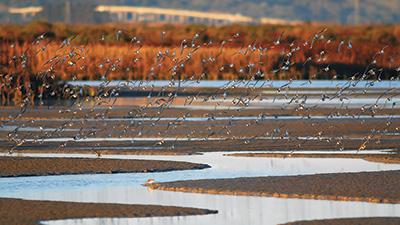 Sandpipers and dowitchers take flight at former salt ponds in the San Francisco Bay National Wildlife Refuge.San Francisco Bay, once plagued by chronic water pollution from 30 cities surrounding it, is continuing its progress toward ecological health, thanks in part to an array of restoration projects and enforcement actions in the bay's watersheds.
Sandpipers and dowitchers take flight at former salt ponds in the San Francisco Bay National Wildlife Refuge.San Francisco Bay, once plagued by chronic water pollution from 30 cities surrounding it, is continuing its progress toward ecological health, thanks in part to an array of restoration projects and enforcement actions in the bay's watersheds.Since 2008, EPA has issued grants totaling more than $36 million for 29 projects to restore wetlands and water quality along the bay's shoreline and tributaries. EPA funding was matched and leveraged by state and local partners for a grand total of $145 million.
Some of the projects involve wetlands in the South Bay, in partnership with the California Coastal Conservancy, U.S. Fish and Wildlife Service, and other state and federal agencies, which are managing the largest tidal wetlands restoration effort on the West Coast.
There, the focus is on restoring former salt evaporation ponds to tidal flats, wetlands, transition zones and open water to support an ecosystem for the endangered salt marsh harvest mouse, Ridgway's rail (formerly known as California clapper rail) and other birds and mammals, while providing flood protection for nearby communities.
Seven projects in the North Bay are preventing further riverbank erosion, which contributes excess sediment to the Napa River. Five more in the South Bay are reducing mercury, polluted runoff and trash in two of San Jose's major watersheds, the Guadalupe River and Coyote Creek.
Meanwhile, settlement of an EPA enforcement action with the East Bay Municipal Utility District (EBMUD) and seven East Bay communities commits $1.5 billion over the next 21 years to assess and upgrade 1,500 miles of sewers, eliminating millions of gallons of sewage discharges into the bay.
At the Port of Redwood City in the South Bay, an enforcement action against scrap metal recycler Sims Metal Management led to a $189,500 fine and measures to investigate and clean up toxic metals from Sims' operation.
See Additional Enforcement Highlights »
- Protecting Vernal Pools »
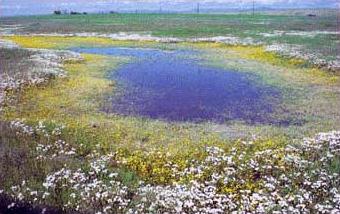 Vernal Pool in CaliforniaCalifornia's climate and geology make it an excellent host to vernal pools – now-rare seasonal depressional wetlands that fill with rain for variable periods from winter to spring, but are completely dry for most of summer and fall.
Vernal Pool in CaliforniaCalifornia's climate and geology make it an excellent host to vernal pools – now-rare seasonal depressional wetlands that fill with rain for variable periods from winter to spring, but are completely dry for most of summer and fall.These unique wetlands of California – 90% of which have been destroyed – are key to the survival of rare and endangered plants and animals.
In the Central Valley, EPA took two separate enforcement actions against individuals who destroyed more than 100 combined acres of vernal pool wetlands. One ranch owner in Tehama County who destroyed 80 acres of vernal pools was required to pay a $300,000 fine and provide $795,000 in mitigation to preserve vernal pool habitat in the Sacramento River basin.
In the second case, a food and nut distributor near Merced in the San Joaquin Valley destroyed 33 acres of vernal pools, and as a result has agreed to pay a $160,000 fine and purchase a 94-acre conservation easement, valued at approximately $1 million, to preserve high-quality vernal pool habitat. Together, these actions will preserve more than 500 acres of vernal pool habitat.
EPA also presented awards to Dr. Bob Holland and Carol Witham to recognize their decades of work in leading California's vernal pool science and protection efforts.
Clean Land
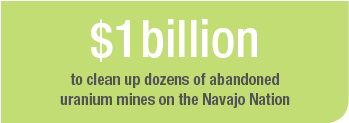

Emergency Response and Cleanup
The Superfund Emergency Response Program investigates and cleans up dozens of incidents each year in the Pacific Southwest.
- EPA Removes Toxics Threatening Humboldt Bay »
The abandoned Samoa Pulp Mill on Humboldt Bay near Eureka, Calif., was a disaster waiting to happen.
When the mill shut down in 2008, it left three million gallons of extremely caustic liquids, 10,000 tons of corrosive sludge, 12,000 gallons of acids, and 3,000 gallons of turpentine, all precariously stored in 20 deteriorating tanks.
The caustic liquids had an extremely high pH of 13 to 14 – strong enough to dissolve wood or flesh. In 2013, the Humboldt Bay Harbor District requested assistance from EPA, which started site stabilization work in September.
Then, on March 9, 2014, a major earthquake measuring 6.8 on the Richter scale shook Humboldt Bay. Because another quake could rupture the tanks, EPA on-scene coordinators sped up plans to remove the toxic liquids.
On March 28, a long stream of tanker trucks began taking the "black liquor" to a mill in Longview, Wash., where it was reused in processing wood pulp to make paper. This $4.5 million removal, the first phase of the estimated $12 million effort, involved five members of the U.S. Coast Guard's Pacific Strike Team, several contractors, and 15 truckers.
The sludges were solidified and trucked to a permitted hazardous waste landfill; the acids were taken to a hazardous waste disposal facility permitted to handle them. On September 10, 2014, the final truckload left the site on Humboldt Bay.
The district plans to reuse the 70-acre site for aquaculture – perhaps growing oysters, or sturgeon to produce caviar.
- Response Follows Explosion at Treatment Plant »
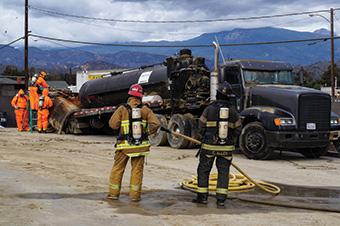 Responders address the aftermath of a chemical explosion in Santa Paula, Calif.At 3:30 a.m. on November 18, 2014, a vacuum truck exploded at the Santa Clara Waste Water Treatment facility in Santa Paula, Calif., releasing the unknown contents of the tanker across the site.
Responders address the aftermath of a chemical explosion in Santa Paula, Calif.At 3:30 a.m. on November 18, 2014, a vacuum truck exploded at the Santa Clara Waste Water Treatment facility in Santa Paula, Calif., releasing the unknown contents of the tanker across the site.Upon drying, the released chemical mixture formed fine crystals that ignited on contact in a flash of fire and small explosions. The ensuing fire caused the release of the facility's inventory of industrial chemicals, including strong oxidizers, acids and polymers.
In the initial response, Ventura County's Office of Emergency Services issued an evacuation order to the community within a one-mile radius. The first responders were forced to abandon two fire trucks that were contaminated onsite. The site was also left with a large ponded area containing a mixture of water and hazardous chemicals, surrounded by a surface coating of the unknown shock-sensitive crystals.
EPA partnered with the Ventura County Environmental Health Division and the facility to implement a safe and effective cleanup. The crystals were neutralized, surfaces pressure washed, and the ponded chemical mixture solidified and trucked to the Chiquita Canyon Landfill. The cleanup was completed on January 9, 2015.
www.epa.gov/region9/disaster/emerresponse.html
Investment Builds Communities
EPA Brownfields grants support community and economic revitalization where reinvestment and jobs are needed most.
- Cities Benefit from Cleanups »
Los Angeles, the San Francisco Bay Area, Honolulu, Nevada's Lyon and Churchill Counties, and Mesa, Ariz., were among 171 urban and rural communities across the U.S. to receive EPA Brownfields funding in 2014.
Gaining more than $2.5 million between them, these six communities will clean up and redevelop contaminated properties into affordable housing, transit-oriented development, commercial redevelopment, and community open space.
In Southern California, local community organizations collaborated to create the Larry Itliong Village, which provides 45 units of affordable, multi-family housing close to public transportation. The project utilized a $200,000 EPA Brownfields cleanup grant and an $88,000 Brownfields revolving loan fund subgrant from the California Department of Toxic Substances Control.
In the San Francisco Bay Area, the City of San Pablo is using $600,000 in Brownfields funding to clean up a former Burlington Northern and Santa Fe rail yard. The property will be developed into a youth soccer facility in a disadvantaged community in need of open space. The project is the result of significant community investment and input and is the cornerstone of planned corridor improvements linking regional transit to a local community college.
In the Central Valley, EPA in 2014 removed three underground fuel storage tanks and tested soil for contamination at a former gas station in Fresno. An additional 37 sites in Fresno County are part of a statewide tank cleanup to help prepare sites for redevelopment.
In Mesa, Ariz., construction of a 3.1-mile extension of the existing regional light rail system along Main Street is underway with the assistance of an EPA Brownfields assessment grant. About 40% of the parcels along the proposed route had historical automotive and industrial operations, resulting in sites contaminated with hazardous substances.
EPA's funding to Mesa complements local efforts to reduce greenhouse gas emissions and the impacts of climate change by providing a world-class transit system.
- Green Job Training »
To ensure that local residents benefit from the jobs created by cleanups, EPA has two training programs for green jobs. Both teach adults the skills needed to secure full-time, sustainable employment in the environmental field.
Last year more than 250 graduates in the Pacific Southwest received environmental cleanup certifications and technician skills through funding from EPA's Environmental Workforce Development and Job Training program. This funding supports local job training organizations serving low-income, minority, unemployed and under-employed people living in areas affected by hazardous waste.
In Rialto in Southern California, 17 local residents graduated from a Superfund Job Training program in July 2014, preparing them for jobs in cleanup projects like the nearby Rockets, Fireworks and Flares Superfund site.
Focus on Tribes
Tribal governments face an array of challenges in protecting public health and the environment on their lands.
- Settlement Brings $1 Billion to Navajo Cleanups »
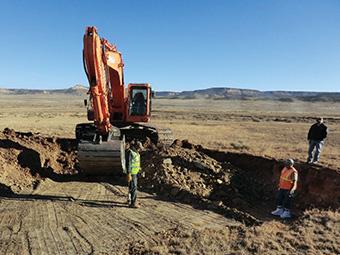 A recent settlement will provide $1 billion to clean up 50 abandoned uranium mines affecting the Navajo.As a result of a historic legal settlement, Kerr-McGee and its parent, Anadarko Petroleum Corp., will pay more than $4.4 billion to fund environmental cleanups across the country.
A recent settlement will provide $1 billion to clean up 50 abandoned uranium mines affecting the Navajo.As a result of a historic legal settlement, Kerr-McGee and its parent, Anadarko Petroleum Corp., will pay more than $4.4 billion to fund environmental cleanups across the country.Among the biggest beneficiaries is the Navajo Nation, where EPA plans to use $985 million from the settlement to clean up about 50 abandoned uranium mines, where radioactive waste remains from Cold War-era Kerr-McGee mining operations.
The Navajo Nation will receive an additional $43 million to address radioactive waste at the former Kerr-McGee uranium mill in Shiprock, N.M. EPA and the Navajo are now working on their second five-year plan to address approximately 500 uranium mine sites on Navajo land.
Kerr-McGee mined more than seven million tons of uranium ore on or near the Navajo Nation from the late 1940s to the 1980s, leaving behind mine sites and contaminated waste rock piles in the Lukachukai Mountains of Arizona, the Eastern Agency of the Navajo Nation, and nearby mines in New Mexico.
Exposure to radioactive elements in soil, air and water poses risks to human health, including lung cancer. EPA awarded an Environmental Justice Collaborative Problem-Solving grant to Tolani Lake Enterprises, a grassroots organization working to assess exposures from water sources.
- EPA, IHS Assist California Tribes in Drought »
Many of California's 109 federally-recognized Indian tribes rely on small drinking water systems that are at risk of running dry during the state's exceptional drought. One small system serving part of the Yurok Tribe on California's North Coast actually went dry in 2014, forcing the tribe to deliver bottled water to customers.
In response to the drought, EPA and the California Area Indian Health Service (IHS) have been working collaboratively with California tribes, encouraging each tribal government to assess their vulnerability, plan for stretching supplies, and identify alternative water sources.
IHS, in partnership with tribes and EPA, identified 13 water systems run by 11 tribes as being at highest risk, with estimated drought-related project needs of $8.6 million. Seven of these tribes made their own drought emergency proclamations, including the Hoopa Valley, Yurok, Tule River, Karuk, Sherwood Valley, Cortina and Kashia Tribes.
EPA has provided funding to eight tribes to develop drought contingency plans, water conservation programs, water audits, leak detection programs and community outreach.
Ultimately, EPA hopes to help tribes develop resilient water systems and sustainable supplies that will be durable in the face of future droughts and other impacts of climate change.
Climate & Communities


Greening Infrastructure
EPA applauds the work of local governments and businesses that are managing their materials through innovative practices to reduce greenhouse gas emissions.
- Communities Act Locally on Climate »
As work continues to secure national and international commitments to reduce greenhouse gas emissions, some local governments in the Pacific Southwest have deployed innovative technologies to green their own infrastructure, creating examples for other municipalities.
San Jose, Calif., now boasts a facility that digests the city's food waste to create biogas and compost, generate electric power, and prevent emissions of methane, the potent greenhouse gas generated when food goes into a landfill.
This is the nation's first – and the world's largest – commercial, dry-fermentation anaerobic digestion facility, owned and operated by Zero Waste Energy Development in partnership with the City of San Jose. The city currently diverts about 74% of its waste from landfills through reuse, recycling, composting, and anaerobic digestion. Its goal is zero waste by 2022.
At the facility, bacteria break down the food and organic matter in 16 digesters, creating methane. The gas is captured to fuel a combined heat and power plant, generating electricity for adjacent recycling operations. The facility can digest 90,000 tons of organic waste per year and generate 1.6 megawatts, enough to sell excess power to the grid. The solid residuals left after digestion are composted onsite to create a valuable soil amendment.
The Victor Valley Wastewater Reclamation Authority (VVWRA), started up a new facility in September that is soon expected to generate 100% of the regional wastewater treatment plant's power from co-digesting sewage sludge and food waste. The VVWRA retrofitted a shuttered anaerobic digester with new technology that increased the amount of organic waste it can handle. The resulting project is expected to replace 9 million kwh of electricity annually – equivalent to taking more than 2,000 cars off the road – and keep 1,400 tons of waste from entering landfills each year.
Phoenix worked with the Arizona Super Bowl Host Committee and the National Football League to achieve a 73% waste diversion rate at this year's Super Bowl festivities. Of that amount, 32% was composted in a pilot food waste and composting program – part of a larger effort to bring curbside collection of food and yard waste and a state-of-the-art composting facility to Phoenix.
- Food Recovery Challenge and New Toolkit Help Reduce Waste »
EPA's Food Recovery Challenge and new Reducing Wasted Food and Packaging Toolkit encourage businesses and organizations to reduce food waste and help feed people in need.
In the Pacific Southwest, challenge participants prevented 847 tons of wasted food, donated more than 55,000 tons and diverted more than 61,000 tons for composting, anaerobic digestion and biofuels production in 2013. The resulting reduction in greenhouse gas emissions was equivalent to taking 10,000 cars off the road.
www.epa.gov/foodrecoverychallenge | Toolkit for Reducing Wasted Food and Packaging
Support for Border Communities
Grants help reduce water pollution, recycle e-waste, and monitor air quality in heavily-populated border areas. Local Residents Benefit in U.S., Mexico.
- Local Residents Benefit in U.S., Mexico »
 An air monitor measures particulate air pollution in San Ysidro, Calif., at the nation's busiest border port of entry.EPA Administrator Gina McCarthy traveled to San Diego in October 2014 to announce more than $8.6 million in grants for environmental improvements along the U.S.–Mexico border.
An air monitor measures particulate air pollution in San Ysidro, Calif., at the nation's busiest border port of entry.EPA Administrator Gina McCarthy traveled to San Diego in October 2014 to announce more than $8.6 million in grants for environmental improvements along the U.S.–Mexico border.The EPA funds were awarded in partnership with the North American Development Bank (NADBank) and the Border Environment Cooperation Commission (BECC). The grants included:
- $5 million to the NADBank for drinking water and wastewater projects to be selected by EPA and the BECC
- $3.5 million to the city of Holtville, Calif., to upgrade its wastewater treatment plant, reducing ammonia discharges to the Salton Sea
- $65,000 to the Sonoran Institute, based in Tucson, Ariz., to clean and restore a segment of the New River in Mexicali, and launch community efforts to prevent illegal dumping
- $49,180 to the California Department of Public Health to assess environmental health disparities, prioritize needs along the border, and target future environmental health efforts
Four months later, Regional Administrator Jared Blumenfeld unveiled a new air monitoring station at the San Ysidro, Calif., border crossing. On average, 50,000 cars and buses and 25,000 pedestrians a day cross at San Ysidro, the Western Hemisphere's busiest land port of entry. Air pollution from vehicles affects communities on both sides of the U.S.-Mexico border.
The new air monitor, funded by a $110,000 EPA grant to the San Diego County Air Pollution Control District, collects data on fine particles (PM2.5) from engine emissions. Health studies have shown a significant association between exposure to fine particles and premature death from heart or lung disease
Focus On Hawaii and Pacific Islands
Educational efforts in the Pacific complement core environmental programs.
- Recognizing Educators »
Kokua Hawaii Foundation and founder/executive director Kim Johnson were recognized by EPA for the organization's work in schools to encourage recycling and environmental stewardship. Their farm-to-school and plastic-free initiatives teach students the value of taking care of their health and the health of the Hawaii environment.
The Plastic-Free Schools program provides resources, tools and trainings to educate school communities on the environmental and health benefits of going plastic-free, to minimize plastic pollution in Hawaii.
EPA also funded two fellowship grants to two graduate students at the University of Hawaii-Manoa for research on the effects of water pollution and climate change on coral reefs. Each will receive $84,000 for two years of research. The projects are:
- Investigating the relationship between land-based sources of pollution and coral reef ecosystem function;
- Acclimatization of Coral Populations to Local and Global Stressors: Can Corals Adapt to Future Threats?
Melanie Blas, a science teacher at Simon A. Sanchez High School in Guam, received EPA's Presidential Innovation Award for Environmental Education. Seventeen teachers and 60 students from across the nation were honored for promoting environmental education and stewardship. The teachers each received $2,500 to further their professional training, and their schools each received an additional $2,500 for environmental education programs.
- Supporting the Outer Pacific Islands »
 Green sea turtles haul out at Tern Island, an uninhabited islet in the Hawaiian Islands National Wildlife Refuge. Photo: Joe SpringIn September 2014, EPA and the U.S. Fish and Wildlife Service released an initial assessment of contamination at Tern Island, a remote island in the chain of Northwestern Hawaiian Islands. The results show that there have been releases of toxics, including polychlorinated biphenyls (PCBs) and lead, from military wastes buried on the island between World War II and 1979, and that further action is warranted.
Green sea turtles haul out at Tern Island, an uninhabited islet in the Hawaiian Islands National Wildlife Refuge. Photo: Joe SpringIn September 2014, EPA and the U.S. Fish and Wildlife Service released an initial assessment of contamination at Tern Island, a remote island in the chain of Northwestern Hawaiian Islands. The results show that there have been releases of toxics, including polychlorinated biphenyls (PCBs) and lead, from military wastes buried on the island between World War II and 1979, and that further action is warranted.The island, 564 miles northwest of Honolulu, is part of the Hawaiian Islands National Wildlife Refuge. It provides habitat for endangered monk seals, sea turtles, and many species of seabirds.
EPA in 2014 awarded over $32 million to Guam, American Samoa and the Commonwealth of the Northern Mariana Islands (CNMI, which includes Saipan), including $25 million to improve drinking water and wastewater service. The remaining $7 million funds local environmental protection work – including inspections, monitoring the safety of beaches, and drinking water, permit issuance, enforcement and other environmental programs.
In 2013, Guam's recycling rate jumped to 32%, from 18% as first reported in 2011 and 28% in 2012. In addition, Guam EPA opened its first household hazardous waste drop-off facility. It's free for island residents and designed to keep household hazardous waste out of Guam's new landfill.
The CNMI Bureau of Environmental and Coastal Quality issued a Climate Change Vulnerability Assessment for Saipan, the first for a U.S. insular area. In American Samoa, the LEED Platinum-certified AS-EPA building, funded in large part by U.S. EPA, became in 2014 one of fewer than two dozen buildings in the world to be certified as "net zero" for energy. AS-EPA's power bill went from more than $60,000 per year to essentially zero.
Enforcement & Stewardship


A Range of Enforcement Tools
California's San Joaquin Valley is taking steps to create a healthier environment while modernizing its infrastructure. High-speed rail promises to benefit both public health and the valley's economy.
- Working Together to Protect Communities »
Enforcement is an essential part of EPA's mission – an important responsibility shared with state, local and tribal partners. Together, robust enforcement programs enable us to better protect our communities from degradation caused by those who violate environmental laws.
At the federal level, EPA strives to ensure that communities across the region receive the same degree of protection from environmental violations. The agency can pursue violations through civil enforcement, or in more egregious situations, criminal enforcement.
EPA has authority to order facilities to comply with environmental requirements. In some cases, those orders are issued by the agency unilaterally, but more often are negotiated. Depending on the nature and scope of the violation, the agency may choose to assess a penalty as well.
EPA has both administrative authority – which allows the agency to issue orders and impose penalties directly – as well as judicial authority. For judicial cases, EPA partners with the Department of Justice to file actions in federal court.
In the end, successful enforcement of environmental laws depends on strong state, local and tribal programs together with focused, appropriate federal responses to non-compliance.
- Enforcement Cases Bring Results »
EPA's 2014 enforcement results were led by a $4.4 billion national settlement with Kerr-McGee Corp. and Anadarko Corp. that allocated more than $2 billion for cleanups of abandoned uranium mines on the Navajo Nation and a groundwater cleanup to protect Lake Mead and the Colorado River. More on this story »
An enforcement action against the East Bay Municipal Utility District (EBMUD) and seven East Bay communities committed $1.5 billion to eliminating sewage discharges into San Francisco Bay. Another enforcement settlement prevents pollution from a bayside scrap metal recycler. More on this story »
A settlement with Costco, one of the nation's largest retailers, will cut its emissions of ozone-depleting and greenhouse gas chemicals from refrigeration equipment at 274 of its stores.
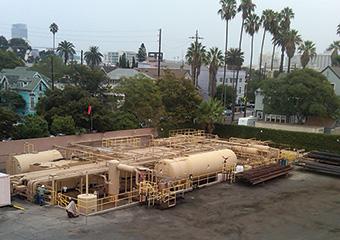 AllenCo has been ordered to improve safety measures at its oil facility in residential South Los Angeles.An EPA inspection of AllenCo, a small oil production operation that generated complaints in a residential neighborhood of Los Angeles, found violations of federal Clean Air, Clean Water, and Community Right to Know laws. The facility voluntarily shut down, entered into a consent agreement to make improvements before reopening, and paid a $99,000 penalty.
AllenCo has been ordered to improve safety measures at its oil facility in residential South Los Angeles.An EPA inspection of AllenCo, a small oil production operation that generated complaints in a residential neighborhood of Los Angeles, found violations of federal Clean Air, Clean Water, and Community Right to Know laws. The facility voluntarily shut down, entered into a consent agreement to make improvements before reopening, and paid a $99,000 penalty.In San Pedro, EPA found violations of risk management plan regulations at a propane and butane storage facility, Rancho LPG, near a residential area. To settle the enforcement action, Rancho LPG invested more than $7 million in new safety controls, tank inspections, seismic upgrades, and improved coordination with emergency responders, and paid a $260,000 penalty.
In Hawaii, EPA found that rental property owner Destination Maui had failed to notify tenants about lead-based paint in their units. To settle the case, the firm is buying blood lead analysis equipment for three health clinics and funding the testing of 350 children. In Northern California, EPA fined several small construction companies for lack of required certification as lead abatement contractors and for violating lead dust rules.
Supporting Research and Innovation
EPA funds research and development by universities and businesses with innovative ideas for less toxic, healthier-to-use materials, fuels and products.
- Grants, Recognition Fuel Advances »
EPA's partnerships with educational institutions and small businesses are a key to ensuring future environmental progress.
Arizona State University received a $5 million EPA research grant to investigate the impacts and hazard potential of nanomaterials throughout their life cycle. Nanomaterials are less than 100 nanometers in size, too small to be seen with conventional microscopes.
University of California at Santa Barbara received a $4.9 million grant to develop an online tool to evaluate life-cycle impacts of chemicals, to better inform industry decision-makers about chemical and product design.
U.C. Berkeley's Center for Green Chemistry received $115,000 to develop a course on using green chemistry techniques to solve real-world business problems. Students will help five companies reduce use of hazardous chemicals in their product and processes, and U.C. will share the results.
Southern California companies receiving Small Business Innovation Research grants for technology development include Biopico Systems for a portable testing system for water-borne pathogens, CLEW for a cost-effective household wastewater treatment and nutrient removal system, and AquaNano for a high-capacity perchlorate filter for drinking water treatment.
Amyris in Emeryville and Solazyme in South San Francisco won Presidential Green Chemistry Awards for creating plant-based fuels and oils. The Bay Area companies were among just five organizations honored nationwide. Amyris engineered a yeast to convert plant-based sugars into a renewable fuel to replace diesel, cutting 82% of greenhouse gas emissions. Solazyme developed renewable oils from sugar and engineered microalgae that significantly reduce wastes, water and energy use compared to petroleum- or existing plant-based oils in soaps, detergents, food products and vehicle fuels.
- Putting Safer Chemicals to Work »
 A lined pond at the Tronox facility in Henderson, Nev., still contains residual perchlorate from the pond's former use in the manufacturing process.In April 2014, Titanium Metals Corporation, also known as TIMET, agreed to pay a record $13.75 million civil penalty and perform an extensive investigation and cleanup of potential contamination stemming from unauthorized manufacture and disposal of toxic PCBs (polychlorinated biphenyls) in Henderson, Nev.
A lined pond at the Tronox facility in Henderson, Nev., still contains residual perchlorate from the pond's former use in the manufacturing process.In April 2014, Titanium Metals Corporation, also known as TIMET, agreed to pay a record $13.75 million civil penalty and perform an extensive investigation and cleanup of potential contamination stemming from unauthorized manufacture and disposal of toxic PCBs (polychlorinated biphenyls) in Henderson, Nev.The penalty was the largest ever imposed for violations of the Toxic Substances Control Act (TSCA) at a single facility. EPA inspections revealed that TIMET had been unlawfully manufacturing PCBs as a by-product, without an exclusion from TSCA's ban.
EPA expects the settlement to result in the removal of 84,000 pounds of PCB-contaminated waste from the environment and prevent the improper disposal of 56 million pounds of hazardous waste each year.
This settlement was part of EPA's nationwide enforcement initiative to reduce pollution from mining and mineral processing, which can generate large volumes of toxic and hazardous waste.
www.epa.gov/greenchemistry | Region 9 Mediacenter: Green Cleaning in San Francisco
Focus on Nevada
Years of enforcement work by EPA and the Department of Justice will help clean up chemical sites and polluted groundwater in Henderson, Nev.
- $1.1 Billion for Henderson Perchlorate Cleanup »
The settlement of a nationwide enforcement case with Kerr-McGee Corp. and Anadarko Corp. has secured $1.1 billion to clean up a former Kerr-McGee chemical manufacturing site that has been contaminating Lake Mead with perchlorate, a component of rocket fuel.
The Kerr-McGee site in Henderson, Nev., near Las Vegas, has the nation's largest plume of groundwater contaminated with perchlorate. The contaminated groundwater flows into Lake Mead, a drinking water source for 15 million people in Nevada, Arizona and Southern California.
The Nevada Division of Environmental Protection began the cleanup several years ago and has removed more than 4,000 tons of perchlorate from the soil and groundwater. Perchlorate can interfere with the production of thyroid hormones, which are needed for prenatal and postnatal growth and development, as well as for normal metabolism and mental function in adults.
The settlement, which covers Kerr-McGee sites in 47 states, sets aside $4.4 billion for environmental cleanup, including $985 million for uranium mining sites on and around the Navajo Nation. More on this story »
- Investigating Vapor Intrusion in Phoenix »
At the Motorola 52nd Street Superfund site in Phoenix, treatment of contaminated groundwater has been underway since 1992.
Since 2011, EPA has also investigated a possible health issue: vapor from groundwater contaminated with toxic trichloroethylene (TCE) rising through the soil into residential and commercial buildings in some areas of the site. So far, EPA has installed mitigation systems in 15 homes near the site to remove TCE from the indoor air.
In 2014, EPA brought in a mobile laboratory to do real-time testing and analysis of indoor air and soil gas. Forty-nine temporary soil vapor wells were installed and sampled, identifying areas where vapor intrusion could be occurring and where further monitoring or mitigation might be needed. As a result, eight homes and two commercial buildings were sampled.
Investigators gathered data on short-term exposures, determined the effectiveness of mitigation systems in some of the homes, and gained better understanding of where further monitoring is warranted. This is vital because of the short-term health effects of TCE in fetal heart development in the early stages of pregnancy.
Continuing monitoring and investigation of indoor vapor intrusion will help inform decisions about where additional indoor air mitigation systems may be needed throughout the Motorola 52nd St. site.
Building Tribal Infrastructure
Building Tribal Infrastructure
$51.5 million
EPA provided $51.5 million in fiscal 2014 to improve environmental protection and public health on tribal lands in the Pacific Southwest. In addition, EPA supports the region's 148 tribes with technical assistance, training and the enforcement of federal environmental laws.
- Clean Land Programs (Brownfields, underground tanks, pesticides): $3.47 million
- Clean Air Programs: $2.96 million
- Clean Water Programs: $28.67 million
- General Assistance Program: $16.42 million

Big Sandy Rancheria
Building Code
The Big Sandy Rancheria Band of Western Mono Indians – a community of about 50 homes and 151 residents in the western Sierra foothills – wanted a building code for new homes that would increase energy efficiency, reduce health problems from poor indoor air quality, conserve drinking water, reduce wastewater, reduce construction waste, and lower maintenance costs.
Big Sandy joined the EPA Tribal Green Building Codes Workgroup, which provided access to a range of building codes, information about moisture and mold, alternatives to spray foam insulation, and more. The Tribal Council favored the Pinoleville Band of Pomo Indians' draft Green Building Code and adapted it for their own use in September 2014.
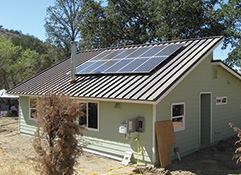
Gila River
Solid Waste Ordinance
The Gila River Indian Community adopted a new solid waste ordinance for their 584-square-mile community, just south of Phoenix, Arizona. The ordinance creates enforceable environmental standards for the storage, collection, transportation and disposal of all solid waste, including hazardous waste generated by businesses and industries on tribal land.
Gila River has been making substantial progress toward sustainability on tribal lands. As development pressures in the area increase, the tribe has pursued alternative energy projects, explored sustainable housing best practices, and considered transportation impacts on community members. Development of its Waste Ordinance was funded in part by an EPA grant.

EPA Funding for FY2014 for the Pacific Southwest Region

- Click for text equivalent of above pie chart
Two pie chart graphs of Regional Operating Budget and Geographic Distribution of Grant Awards. Regional Operating Budget ($ in millions): Grants=71%/$437.2M, Payroll and Support=18%/$113.8M, Contracts=11%/$67M.6M. Geographic distribution of Grants portion of budget (in millions): California=$288M, Arizona=$66M, Nevada=$36M, Hawaii=$20M, Guam=$12M, American Samoa=$11M, CNMI=$9M, Other=$4m
About 82% of the $618 million operating budget appropriated by Congress for EPA's Pacific Southwest Region flows to state and tribal agencies, local governments, nonprofit organizations and private-sector companies in the form of grants and contracts.
This funding pays for drinking water and wastewater infrastructure, clean air programs, Superfund site cleanups, rehabilitation of contaminated lands, and many other activities supporting communities and public health.
For more information on grants, visit www.epa.gov/grants.
Regional Funding by Strategic Goal
All told, more than half of regional funding is applied toward the goal of Protecting America's Waters. Most of the $341 million in grants awarded under this goal goes to the State Revolving Fund, which supports drinking water and wastewater infrastructure as well as nonpoint source pollution and estuary protection programs.
- Click for text equivalent of above pie chart
Regional Funding by Strategic Goal Graph. Approximately(and in millions of dollars): Improving Air Quality/Climate Change -$60M, Protecting America's Waters - $375M, Cleaning Up Communities/Advancing Sustainable Development - $125M, Ensuring Safety of Chemicals and Preventing Pollution - $12M, Enforcing Environmental Laws - $45M
Distribution of Grant Funding
The majority of EPA's grant funding goes to state and tribal agencies for environmental work. (In the Pacific islands, all of EPA's financial support goes to government agencies.) The charts show who receives funding in each of four major geographic areas.
- Click for text equivalent of above pie chart
Distribution of Grant Funding: California - $288M, Nevada - $36M, Arizona - $56M, Hawaii - $20M
Regional Administrator's Letter
 Jared BlumenfeldDear Readers,
Jared BlumenfeldDear Readers,
The world around us is changing. EPA is taking the lead in helping communities develop resiliency by turning challenges into opportunities for innovation and creativity. From renewable power to green infrastructure, EPA is deploying our funding and technical expertise to every corner of the Pacific Southwest.
We are privileged to work with 148 tribes in Arizona, California and Nevada. These sovereign nations are models of resiliency and adaptation. In this time of severe drought we can learn from tribes like the Hopi, who for thousands of years have been dry farming corn without the aid of irrigation. We are also working hard to bring justice to tribes like the Navajo, whose reservation contains hundreds of abandoned uranium mines. This year we secured more than $1 billion from a polluter to clean up 50 of these toxic sites.
I've visited 115 tribal communities in our region to meet with tribal elected representatives and see firsthand the amazing work tribes are doing to protect their environment. You'll find some success stories on the pages that follow, from the Pyramid Lake Paiute Tribe's creation of wetlands to protect water quality in the Truckee River, to the Gila River Indian Community's new waste ordinance, which creates enforceable standards for storage, collection, and disposal of hazardous and solid wastes.
We bring the same focus and energy to challenges throughout the Pacific Southwest – reducing air pollution in the San Joaquin Valley, helping water utilities provide safe drinking water while adapting to drought and climate change, responding to toxic emergencies, cleaning up contaminated sites, and supporting zero-waste initiatives and green infrastructure to reduce greenhouse gas emissions.
If you look around at the environmental progress in the Pacific Southwest, I'm sure you'll agree – together, we're making a visible difference in our communities.

Jared Blumenfeld
Regional Administrator
EPA Pacific Southwest Region







